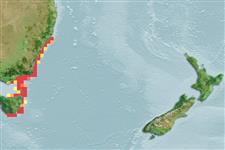>
Lophiiformes (Anglerfishes) >
Brachionichthyidae (Handfishes)
Etymology: Brachionichthys: Latin, bracchium = arm + Greek, ichthys = fish (Ref. 45335); hirsutus: Name from Latin 'hirsutus' for hairy, in reference to its rough, hairy skin.(Ref. 82446).
More on author: Lacepède.
Environment: milieu / climate zone / depth range / distribution range
экология
морской демерсальный; немигрирующий; пределы глубины 1 - 60 m (Ref. 72490), usually 5 - 15 m (Ref. 72490). Temperate; 41°S - 44°S, 147°E - 149°E
Southwest Pacific: Endemic to Tasmania, Australia. Has been nearly wiped out by an introduced starfish which preys on its egg clusters (Ref. 27438).
Size / Вес / Возраст
Maturity: Lm ? range ? - ? cm
Max length : 15.0 cm TL самец/пол неопределен; (Ref. 7300)
Краткое описание
определительные ключи | морфология | морфометрия
членистые (мягкие) лучи спинного плавника (общее число) : 19 - 21; членистые (мягкие) лучи анального плавника: 8 - 10. This species is unique in having the following set of characters: esca small, 15-26% (mean 20%) of illicium length (including esca); illicium very slender, no dermal spinules, length 19-20% SL (mean 20%), 2.3-2.4 times in head length; eye moderate, exceeding 5.4 times in head; body entirely covered with close-set, non-imbricate scales; scale bases subcircular with long
unicuspid spinules (except for those closely-associated with pores of the acoustico-lateralis system); spinules originating from middle of scale base, variable in length over body; second dorsal-fin rays 17-19 (mean 18), fin base 61-64 (mean 62%) SL; first ray of first dorsal fin length 0.7-1.0 times length of longest ray of second dorsal fin; anal-fin rays 8-10; pectoral-fin rays usually 7 ; upper body usually covered with fine dark spots or short streaks (rarely with long streaks on head); caudal fin with dense coverage of fine spots, forming a dark submarginal bar in juveniles (Ref. 72490).
Occurs in the continental shelf and inshore waters (Ref. 7300). Occurs in coarse to fine sand habitats in depths of 5-40 m (most commonly 5-10 m). Often found in shallow, shell-filled depressions or near rocks of low relief projecting from the substrate (Ref. 30684). Length only preliminary, replace with better value (RF). Egg masses contain about 80-250 eggs, about 1.8-2 mm in diameter; egg capsules about 3-4 mm diameter. Newly hatched juveniles are about 6-7 mm SL, attaining at least 9.0 cm SL (about 13.0 cm TL), with adults commonly about 6.0-7.5 cm SL (Ref. 72490).
Life cycle and mating behavior
половая зрелость | размножение | нерест | икра | Fecundity | личинки
Paxton, J.R., D.F. Hoese, G.R. Allen and J.E. Hanley, 1989. Pisces. Petromyzontidae to Carangidae. Zoological Catalogue of Australia, Vol. 7. Australian Government Publishing Service, Canberra, 665 p. (Ref. 7300)
Статус Красного Списка МСОП (Ref. 130435: Version 2024-2)
Угроза для людей
Harmless
Использование человеком
дополнительная информация
инструменты
Специальные отчеты
Скачать в формате XML
ресурсы в Интернет
Estimates based on models
Preferred temperature (Ref.
123201): 13.5 - 21.2, mean 15.8 °C (based on 68 cells).
Phylogenetic diversity index (Ref.
82804): PD
50 = 0.7501 [Uniqueness, from 0.5 = low to 2.0 = high].
Bayesian length-weight: a=0.00389 (0.00180 - 0.00842), b=3.12 (2.94 - 3.30), in cm total length, based on all LWR estimates for this body shape (Ref.
93245).
Trophic level (Ref.
69278): 3.3 ±0.39 se; based on food items.
Fishing Vulnerability (Ref.
59153): Low vulnerability (10 of 100).
